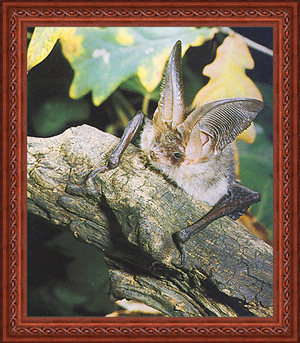
Plecotus auritus
Common Long Eared Bat
Of all the British bats this is one that you cannot fail to recognise, no other mammal has ears nearly as long as its body. This bat doesn't fly about throwing out ultra-sonic waves ad lib it whispers and it can tell the difference between the insect and the leaf it is sitting on. The huge ears detect these minute echoes and can distinguish echoes from different textures such as a caterpillar or a leaf or a hard shelled insect. They can also hunt by site. Large prey items may be taken to a perch, which can be identified by the heap of insect remains on the floor below.Another clever ability it has is that can hover at an angle of 30° and can pick it's prey off branches leaves with great accuracy, hence , it has access to a lot of insects and larvae that the other bats do not exploit.
General Biology:
Size:Head and Body 37 - 48 mm ( 1.5 inches ) Weight is 6 - 12 grams ( 1/5 - 1/4 oz ) An average male weighs 10% less than the females
Colour: Yellow buff on top and buff underneath
Breeding Season: Summer
Gestation Period: Sixty to seventy days though not known exactly.
Number of Young: One baby is born usually in the last week of June. They grow quickly and begin to fly after 3 weeks and at six weeks old can forage for themselves
Food: Mostly moths insects and larvae (caterpillars)
Predators: Owls cats and men
Distribution: Widespread throughout the British Isles, except for the North of Scotland.In April and May maternity roosts typically of 10-50 females form, and unlike many species of bats, males also occur in these roosts
The female brown long-eared bat becomes sexually mature at around one year old. The males do not become sexually mature until about fifteen months old. The maximum lifespan of the brown longer-eared bat is recorded to be thirty years. But the average is seven for the males and sixteen for the females.